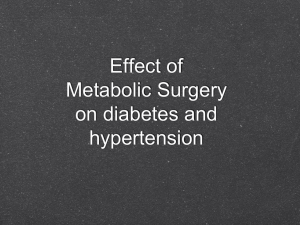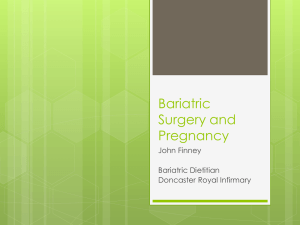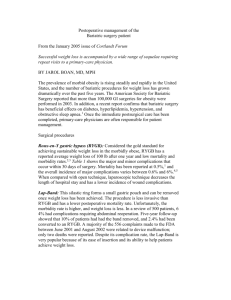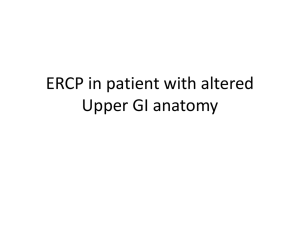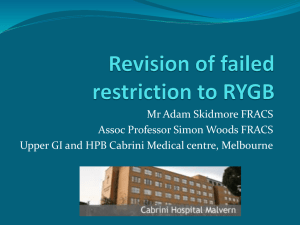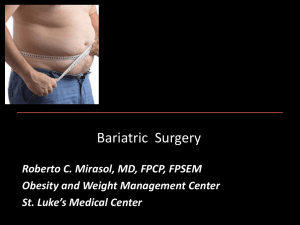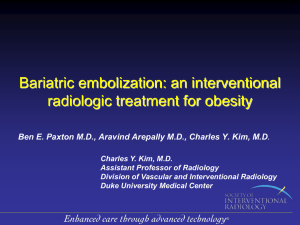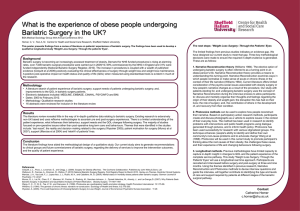Bariatic_surgery_till_death_do_we_part_5
advertisement
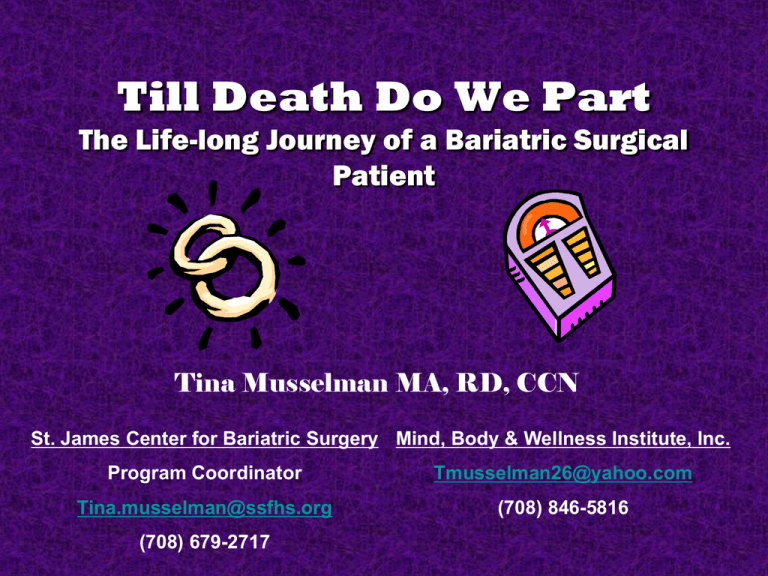
Till Death Do We Part The Life-long Journey of a Bariatric Surgical Patient Tina Musselman MA, RD, CCN St. James Center for Bariatric Surgery Mind, Body & Wellness Institute, Inc. Program Coordinator Tmusselman26@yahoo.com Tina.musselman@ssfhs.org (708) 846-5816 (708) 679-2717 Obesity…Intervention BMI RYGB, AGB (BMI 30), Duodenal Switch, Gastric Sleeve Surgery 35 Phentermine, Meridia, Xenical (Byetta), Band(?) Pharmacotherapy 30 Lifestyle Modification Diet Physical Activity 25 http://cme.medscape.com/viewarticle/712986?src=cmemp&uac=98478HV The Reality of Bariatric Surgery # of bariatric cases grew 400% from 1998-2004 – 13,386 to 121,055 per year – 220,000 performed in 2008 82% of surgical cases are female Age – Ages 18-54 accounted for 85.2% of all surgeries – FASTEST GROWTH IN BARIATRIC SURGERY IS FOR AGES 55-64 (20 fold increase) RD’s can run, but we cannot hide! Healthcare Cost and Utilization Project, Statistical Brief #23 (January 2007) Eligibility BMI – BMI 35-39.9 with 1 - 2 obesity-related co-morbidities (DM, HTN, dyslipidemia, severe OA, OSA, Pickwinian Syndrome) – BMI > 40 – New indications for Lap Band - BMI 30-34.9 (not covered by insurance yet) Age – Adults over 18 – Controversy over 65 y.o. - evaluated case by case – Adolescent trials are currently being done Growth must be completed Some insurances may cover it “Exhausted all non-surgical weight loss options” CKD/ESRD is NOT a contraindication Adjustable Gastric Band (Lap Band® & Realize Band) 1988 approved by FDA in June 2001 15 ml pouch Adjustable stoma size Digestive tract remains in tact 2/2011 - Lap Band approved for BMI 30-35 + co-morbids Roux en Y Gastric Bypass (RYGB) 1971 15-30 ml pouch Roux limb 75-150 cm – Longer in Super Obese Biliopancreatic Limb – Carries gastric juice – Bile and Pancreatic juice – 15-60 cm Distal Common Channel – 200-500 cm – All of the ileum and some jejunum – Bulk of digestion and absorption RYGB vs. AGB (Lap Band) RYGB AGB Weight Loss 70% EBW at 1 yr. 20# wt regain around 2 yrs. Post-op 50% EBW at 2 yrs Wt loss may stabilize at 4 yrs post op Short Term Complications 1 yr. post op 0.5% mortality Similar to any surgery Anastomotic Leak Stomal Stenosis (4.9%) Internal Hernia (2.5%) Gallstones (1.4%) Suture Line Ulcers (1.4%) Staple Line Failure (1.0%) Bleeding (0.9%) Death (0.6%) Dehydration Hair Loss (iron and Protein) 0.1% mortality Similar to any surgery Gallstones Dehydration RYGB vs. AGB (Lap Band) RYGB Long-Term Complications Misc… AGB Hypoglycemia Gastro-gastric Fistula Stomal Stenosis Bowel Obstruction Nutritional (peaks >5 yrs. post op) - B12, Folic Acid, Iron, Calcium, Vit D Weight Regain Loss of LBM Vomiting more common Gastric prolapse Obstruction Esophageal and pouch dilation Gastric erosion and necrosis Port access problems Weight regain Dumping Syndrome Gradual shift away from solid food Treatment and Outcomes, FNCE Pre-symposium Workshop by Chris Eagon, MD; October 2005 5 year comparison Band has the highest safety profile for all bariatric procedures The “new kid on the block” in bariatrics Laparoscopic Sleeve gastrectomy Partial Gastrectomy (60-80% removed) Small bowel remains intact Founded as part of the first step in a two step surgical process for the super obese New- more to learn about sustainability and safety Results similar to RYGB SG Weight Loss Short Term Complications 1 yr. post op Long Term Complications 62-69.4% EBW loss at 18 mos Similar to any surgery bleeding Fistula Stenosis/obstruction Staple line leak GERD (0-83%) Gerd (5% at 2 yrs) Nutritional deficiencies ? ? Chouillard et al. Laparoscopic RYGB vs Sg for morbid obesity: Case controlled study.. SOARD 2011; 7: 500-505. Micronutrition Factors common to all procedures that increase nutritional risk – – – – – Poor eating behaviors, Decreased nutrient dense foods Food intolerance Restricted portion sizes (Emesis) Micronutrition - Gastric Bypass Etiology: – GERD (PPI’s) – Emesis – transit time/diarrhea Most common deficiencies – Iron (20-51%): HCl – B-12 (35%): HCl, IF – Vit D – Ca – Folate (41-47%) Micronutrition - Gastric Bypass Etiology: – GERD (PPI’s) – Emesis – transit time/diarrhea Most common deficiencies – Iron (20-51%): HCl – B-12 (35%): HCl, IF – Vit D – Ca – Folate (41-47%) 63% of pts developed nutrition deficiencies (Fe, B12, folate) 2 yrs. Post RYGB including those who were compliant with the vitamin regimen. (n=140) - Brolin, et al 1991 Micronutrition - Sleeve gastrectomy Etiology – transit time – Emesis/Nausea – GERD (PPI’s) – HCl Common nutrient def. – B12: 18% ? – Fe: 18% ? – Zn: 35% ? – Folic Acid? – Vit D? Micronutrition - Sleeve gastrectomy Little data on micronutrition and SG 1 yr. results without MVI – 4.9-43% Fe def. – 9-18.1% B12 def. – 9.8-22% folate def. Jacques, J., Goldenberg, L. Nutrition and the sleeve gastrectomy patient: From micronutrients to dietary patterns. Bariatric Times 2011; 8(6):12-15. Micronutrition - AGB Etiology – po intake – Food intolerance – Maladaptive eating Micronutrition - AGB Etiology – po intake – No alterations to digestive processes -“AGB has minor effects on normal physiological digestive processes and, as a result, selective nutritional deficiencies are presumed to be unusual…Closer clinical follow up is more necessary (adjustments) after AGB than RYGB, whereas the reverse is true for perioperative nutritional evaluations.” - Ziegler, O., Sirveaux, MA, et al, Diab. & Met. 2009, p. 544 & 553 Micronutrition - Summary - very rare + rare + frequent ++ very frequent AGB RYGB SG Protein - + -(?) Iron + ++ + B12 + ++ +(?) Ca/D - or + ++ -(?) Folate + + + B1 + + +(?) Zn/Se + ++ (?) A, E, K - - or + - Vomiting ++ ++ + Ziegler, O., Sirveaux, MA., et al. Medical follow up after bariatric surgery: nutritional and drug issues General recommendations for the prevention and treatment of nutritional deficiencies. Diab. & Metab 2009; 35: 544-557. The Standard Supplementation “There is little agreement on exactly how to manage micronutrition in post-operative bariatric surgery patients.” - Jacqueline Jacques, ND Micronutrition for the Weight Loss Surgery Patient (2006) Many patients will be malnourished pre-operatively leading to more aggressive supplementation after surgery – 51-62% pre-operative Vit D deficiency Obese individuals may have needs above and beyond normal recommendations – Contributing mechanisms Multiple medications Years of poor diet Underlying inflammation Recommended Supplementation AGB Multiple vitamin 1,000 mg Calcium B complex Bile salt replacement RYGB/SG Multiple vitamin x 2 (100% RDA including iron) Sublingual B12 1,500 mg Ca + D Thiamin (B complex)? Supplemental iron for menstruating women? Bile salt replacement prn Tablets or capsules can be tolerated 6 mo. and beyond Multiple Vitamin and Calcium should not be taken together and should be in divided doses Common “Bariatric” Eating Guidelines 1. Protein and Produce - At least 60 g. protein/day - Liquids and “mushy” calories not recommended - Foods not tolerated well: bread, rice, dry meat, some produce 2. 2-3 meals per day - breakfast optional - limited snacking 3. Avoid eating and drinking at the same time 3. 1200-1400 calories per day long-term A word about renal disease and bariatrics Bariatric Surgery improves DM, obesity and HTN, three of the leading causes of renal disease “The more earlier we treat CKD in the disease process with bariatric surgery, the more favorable the impact on the kidney.” Wei-Jei Lee. Be aware of medical absorption changes Monitor labs and adjust vitamins/macronutrients as appropriate Thank You! Tina Musselman RD, CCN St. James Center for Bariatric Surgery Program Coordinator Tina.musselman@ssfhs.org (708) 679-2717 Mind, Body & Wellness Institute, Inc. tmusselman26@yahoo.com (708) 846-5816
